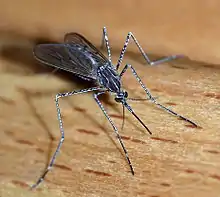Culiseta
Culiseta is a genus of mosquitoes. Most Culiseta species are cold-adapted, and only occur in warmer climates during the colder parts of the year or at higher elevations where temperatures are lower. Species found in Southern California are larger than most mosquitoes species, specifically Cs. inornata, Cs. particeps, and Cs. incidens. These species are found throughout the year in Southern California and feed on several vertebrate species, such as birds, livestock, rodents, reptiles, and humans.[2][3] The larvae of most species are found bogs, marshes, ponds, streams, ditches, and rock pools, but an African species occurs in tree holes ("phytotelmata"), a common eastern Palaearctic species occurs in water wells and rock pools, and several Australian species occur under ground. Little is known about the blood-feeding habits of females. Most species feed on birds and mammals, but a few feed on reptiles. Several species attack domestic animals and occasionally humans,[4] and some species are pollinators.[5]
| Culiseta | |
|---|---|
 | |
| Culiseta longiareolata | |
| Scientific classification | |
| Kingdom: | |
| Phylum: | |
| Class: | |
| Order: | |
| Family: | |
| Subfamily: | |
| Tribe: | Culisetini |
| Genus: | Culiseta |
| Species | |
|
Culiseta alaskaensis | |
Culiseta species are found throughout the world, except in South America.[4] Two extinct species are known from the Eocene Kishenehn Formation in Montana[6]
References
- "Nematocera by Markku Savela". Lepidoptera and some other life forms. Retrieved 2007-12-13.
- Identification of the Mosquitoes of California. Richard Meyer and Stephen Durso, Mosquito and Vector Control Association of California. 1998.
- Sandhu TS, Williams GW, Haynes BW, Dhillon MS. Population dynamics of blood-fed female mosquitoes and comparative efficacy of resting boxes in collecting them from the northwestern part of Riverside County, California. J Global Infect Dis [serial online] 2013 [cited 2013 Oct 22];5:15-8.
- "GENUS Culiseta". The Walter Reed Biosystematics Unit. Archived from the original on 2007-06-22. Retrieved 2007-12-13.
- Peach, Daniel A. H.; Gries, Gerhard (2019). "Mosquito phytophagy – sources exploited, ecological function, and evolutionary transition to haematophagy". Entomologia Experimentalis et Applicata. n/a (n/a). doi:10.1111/eea.12852. ISSN 1570-7458.
- Harbach, Ralph E.; Greenwalt, Dale (2012-10-30). "Two Eocene species of Culiseta (Diptera: Culicidae) from the Kishenehn Formation in Montana". Zootaxa. 3530 (1): 25. doi:10.11646/zootaxa.3530.1.2. ISSN 1175-5334.
External links
 Data related to Culiseta at Wikispecies
Data related to Culiseta at Wikispecies- "Mosquitoes of California". Alameda County Mosquito Abatement District. Archived from the original on 2008-11-21. Retrieved 2007-12-13.
- "New Jersey's 63 Mosquitoes". New Jersey Mosquito Homepage. Archived from the original on 2007-12-11. Retrieved 2007-12-13.
- Fatma K. Adham; Leaf, HL (December 1982). "Establishment of a colony of the mosquito Culiseta longiareolata under laboratory conditions". Cellular and Molecular Life Sciences. 38 (12): 1498–1499. doi:10.1007/BF01955792. OCLC 14209071. PMID 6129996.
- Culiseta melanura, black-tailed mosquito on the UF / IFAS Featured Creatures website.